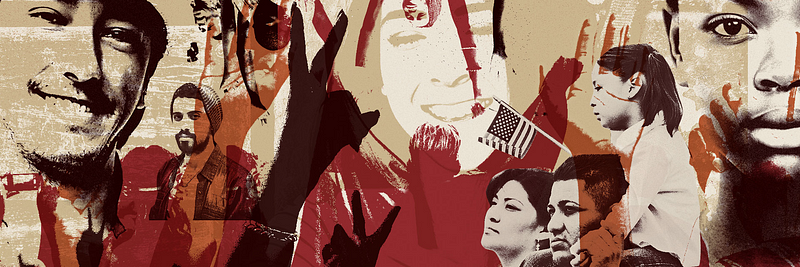An Immerse response
 Fusion’s
Rise Up: Be Heard fellows partnered with USC Annenberg’s Civic Paths to envision a better world.
Fusion’s
Rise Up: Be Heard fellows partnered with USC Annenberg’s Civic Paths to envision a better world.
Despite all the pressure for newsrooms to focus on clicks and views that drive programmatic ad buys, there are signs of a growing commitment for investing in innovation across news organizations.
However, we must think carefully about how those investments are being made, what expectations organizations have for innovation initiatives, and how those initiatives have impact across newsrooms.
To contrast with the examples in Aleszu Bajak’s piece, I’ll share the story of my own attempt to run just such a group.
For 20 months, in 2015–2016, I worked with Univision/Fusion Media Group to found and run a Center for Innovation & Engagement. Along with my colleague Federico Rodriguez Tarditi, I took an approach significantly different than those Bajak covered.
Our Center was not “a lab.” In fact, we didn’t make any experimental news products while we were there.
Rather, our goal was to be an inspirer, an educator, a catalyst, and a facilitator for enabling as many different groups as possible to experiment with new ways to tell stories and new ways to connect with audiences, beyond what they were already naturally doing. In other words, we wanted as many teams as possible to feel innovation was their job and to support them in trying approaches that were realistic within their time and budget constraints.
Most of that work involved matching an internal team with an external partner to explore something our teams hadn’t tried before. Sometimes, our work began with an internal team’s dream which they weren’t sure how to accomplish. Often, it involved bringing initiatives outside our walls to the attention of various teams internally, in hopes of enticing someone to play. But, in all these cases, we wanted to inspire our teams through these outside partnerships and bring that spirit of collaboration to as many groups as we could feasibly manage.
We also found as many ways as we could to bring representatives from our teams into the spaces of external partners, most often through sponsoring and co-organizing conferences.
As part of this work, we helped foster unique co-production relationships:
- We partnered our investigative team with a mobile game developer to explore gerrymanding simultaneously through an intertwined investigative special and mobile game called Rigged.
- We forged relationships between our teams and academic initiatives at places such as USC Annenberg (examples here, here, and here), University of Chicago (examples here, here, and here) and MIT (examples here, here, here, and here).
- We worked with nonprofit projects such as the Internet Archive’s Political TV Ad Archive (examples here and here) and the WITNESS Media Lab.
- We tried using experimental platforms such as Deepstream and Vojo to tell unexpected stories and/or tell those stories in new ways.
 Fusion
partnered with the MIT Media Lab’s Laboratory for Social Machines to track the ways in which Trump’s
campaign dumbed down the Twitter conversation
about immigration.
Fusion
partnered with the MIT Media Lab’s Laboratory for Social Machines to track the ways in which Trump’s
campaign dumbed down the Twitter conversation
about immigration.But we believed a lot of innovation work wasn’t necessarily about creating stories using an experimental feature or platform. Our work included, for instance, research focused on understanding how better to serve our most dedicated audiences and finding pathways to better connect those doing research work on various teams across our portfolio of companies.
We also incubated a new “community liaison” position, aimed at connecting our teams’ stories to the communities most likely to care about them most deeply (See a bit about their work in this Nieman Lab feature).
Through this team, and other partnerships, we sought to foster ongoing relationships with community members to better understand underreported issues and, where possible, to find opportunities to feature those voices directly. I firmly believe that finding new ways to maintain productive relationships with the communities served by your work, and exploring new co-creation storytelling approaches, is among the most vital long-term innovation work for journalism.
Across all this work was another common concern: metrics. As the old methods of measuring reach, views, clicks, and shares proves increasingly untenable, it’s crucial for innovation work within an organization to be dedicated to means of measurement like depth of engagement, completion rate, story shelflife, and projects that help to establish and strengthen the strength of the news organization’s brand. (More on this in my recent Nieman Lab 2017 prediction piece.)
When significant layoffs came to Univision, though, our Center was swept up in that tide.
That is a common refrain for innovation groups and labs inside a news organization; even when the budgets are lean for such groups, they can seem among the hardest for companies to justify keeping through a change in leadership or a quarter that doesn’t meet financial expectations.
In fact, that precariousness of news organizations’ commitment to invest in innovation is why I think it’s especially important for newsrooms to work with partners in academia and at nonprofits, who are less likely to have their focus on crucial long-term questions disrupted by shifting momentary company priorities, this month’s traffic goals, or budget shortfalls.
And that precariousness is also why it’s crucial for innovation efforts to emphasize making the whole company “the lab.” Too often, you can’t be sure how long investments in these efforts within a newsroom will last, so making sure experimentation isn’t quarantined is key for knowing you’ve had a lasting impact.
Find more about Sam Ford’s work at https://samford.wordpress.com.
Immerse is an initiative of Tribeca Film Institute, MIT Open DocLab and The Fledgling Fund. Learn more about our vision for the project here.